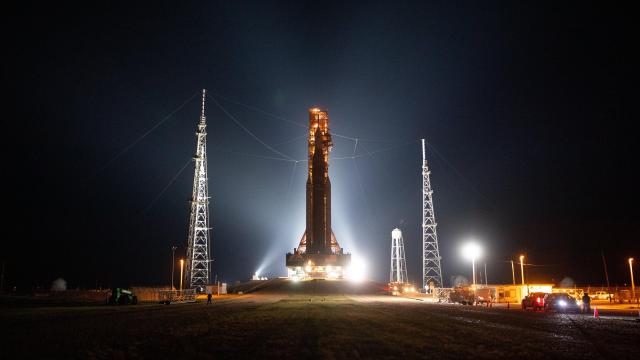NASA’s mission management team has made the decision to re-attempt a launch of the Artemis 1 Mission’s Space Launch System on Saturday afternoon, saying a faulty sensor was to blame for the scrub this past Monday.
The space agency’s 98.15 m-tall Space Launch System (SLS) is currently standing proud on Launch Pad 39B at Kennedy Space Centre in Florida, but hopefully for not much longer. After reviewing the data from Monday’s scrub, NASA’s mission management team has decided to proceed with the mission, telling reporters on Tuesday evening that the next launch attempt will occur on Saturday. NASA had previously selected Friday September 2 and Monday September 5 as possible launch days, so the decision to attempt a launch on Saturday came as a complete surprise.
At the briefing, Marc Berger, a meteorologist with the U.S. Air Force’s Weather Squadron, assessed a 60% chance of a weather violation occurring within the launch window. Sounds discouraging, but Berger said the afternoon showers are likely to be sporadic and that they “tend to have a lot of real estate between them,” so an opportunity to launch will likely present itself within the two-hour window. Artemis launch director Charlie Blackwell-Thompson said that, in the event of scrub caused by inclement weather, another launch attempt could be made within 48 hours.
All eyes are on Kennedy Space Centre, as NASA attempts to launch the largest rocket the space agency has ever built. Departing the launch pad with 8.8 million pounds of thrust, SLS will attempt to deliver an uncrewed Orion capsule to space, where it will perform a round-trip to the Moon and back. Artemis 1 is a test mission that’s meant to set the stage for a crewed Artemis 2 mission in 2024 and a crewed Artemis 3 mission to the lunar surface later this decade. Through its Artemis program, NASA is attempting to return humans to the lunar environment and keep them there.
The reason for Monday’s scrub had to do with a core stage engine not reaching the ultra-cold temperature required for launch. Speaking to reporters on Tuesday, John Honeycutt, manager of the SLS program, said the problem was the result of a faulty sensor, rather than the engine failing to reach its desired chilldown temperature. “We’re seeing some goodness in the data,” he said, which is leading the team to be optimistic about the next attempt to chill the engines. That said, Honeycutt said his team is developing a plan should a similar engine reading appear during Saturday’s launch attempt. “We will have a plan for a go/no-go rather than us sitting around scratching our heads,” he added.
Mike Sarafin, Artemis mission manager, said a tweak will be made to the loading procedure, as teams will initiate the engine chilldown procedure earlier than usual. SLS features four RS-25 engines that need to be ultra-cool prior to the sudden influx of cryogenic propellants during launch. On Monday, sensor readings indicated that engine #3 failed to reach the target temperature, but NASA says it very likely did reach the desired temperature of approximately -250 degrees Celsius.
In addition, teams will perform work at the pad to address the leak seen at the hydrogen tail service mast umbilical, Sarafin added. Said Blackwell-Thompson on the upcoming pad work: “We want to do some inspections and want to do some re-torques.”
Monday’s scrub prompted criticism from experts, who complained that NASA essentially used the launch attempt as a fifth wet dress rehearsal. Four prior trial runs held earlier this year were not run to full completion, with approximately 10% of test objectives unaccounted for. Aside from the Green Run tests performed at Stennis Space Centre in Mississippi, the launch countdown has not proceeded past T-29 seconds.
SLS might take flight on Saturday, but it will require NASA to venture into uncharted territory, particularly during the very late stages of the launch. Hopefully, NASA’s extensive experience with rockets will prevail, and we’ll finally get to see this majestic rocket soar through the Florida skies.
